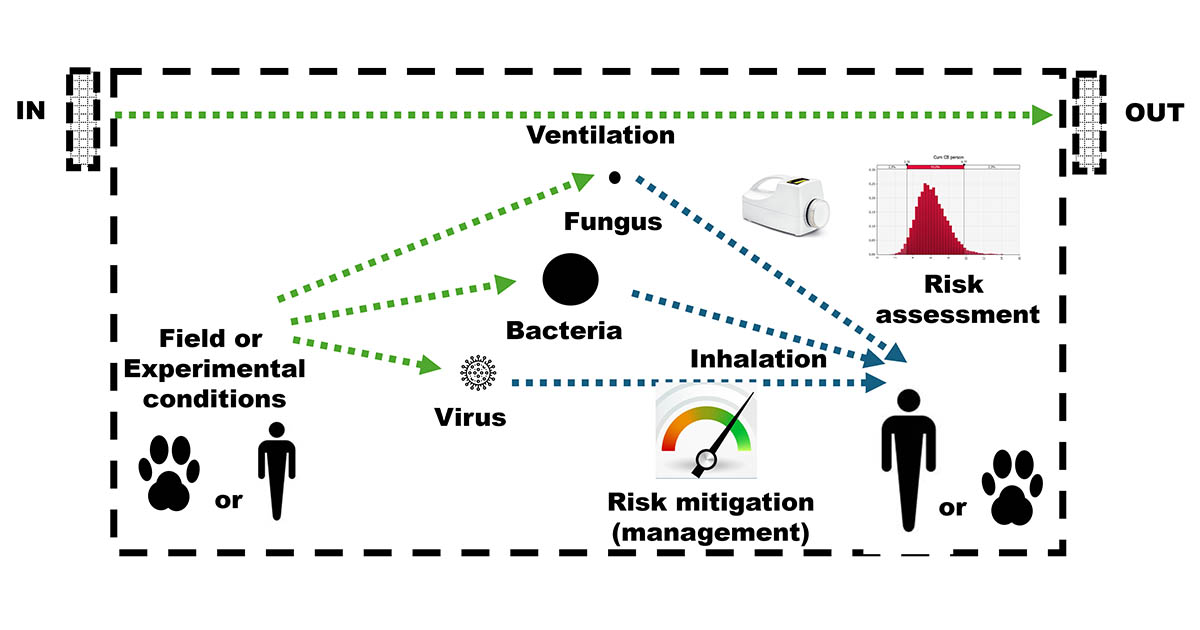- 3.3Impact Factor
- 6.8CiteScore
- 14 daysTime to First Decision
Airborne Transmission of Pathogens
This special issue belongs to the section “Viral Pathogens“.
Special Issue Information
Dear Colleagues,
Aerosol exposure occurs when pathogenic agents contained in aerosol droplets are passed from one animal or human to another, from animal to human, or from human to animal. To be infectious, pathogenic agents must survive for sufficient periods of time within their environment, i.e., the aerosol droplets. Proximity of infected and susceptible animals/humans is required for disease exposure. Ventilation of the room where animals/humans live or other mitigation measures (e.g., distance between emitter and receptor, biosecurity measures) are also factors to be considered in experimental (e.g., laboratory or facility) or field conditions (e.g., meeting room, bus, flight, farms). In certain conditions, droplets containing disease agents can pass through the air and are inhaled. Airborne transmission is effective for a variety of diseases depending on the species (e.g., foot-and-month disease, anthrax, Q fever, tuberculosis, aspergillosis, Mycoplasma hyopneumoniae, Klebsiella pneumoniae, pasteurellosis, human influenza, SARS-CoV-2, avian influenza, swine influenza, equine influenza, calicivirus), and several are zoonoses. Moreover, certain pathogens share antimicrobial resistance genes. This Special Issue is a perfect example of the use of the One Health approach to better understand airborne transmission.
I would like to invite colleagues investigating any of the pathogenic agents transmitted by airborne within the areas of their sampling detection (especially live pathogens), ecology, epidemiology, risk analysis, modelling, and mitigation measures, including individual protective equipment, to submit their manuscripts to this Special Issue in the form of original research and reviews.
Prof. Dr. Claude Saegerman
Dr. Ann Packeu
Guest Editors
Manuscript Submission Information
Manuscripts should be submitted online at www.mdpi.com by registering and logging in to this website. Once you are registered, click here to go to the submission form. Manuscripts can be submitted until the deadline. All submissions that pass pre-check are peer-reviewed. Accepted papers will be published continuously in the journal (as soon as accepted) and will be listed together on the special issue website. Research articles, review articles as well as short communications are invited. For planned papers, a title and short abstract (about 250 words) can be sent to the Editorial Office for assessment.
Submitted manuscripts should not have been published previously, nor be under consideration for publication elsewhere (except conference proceedings papers). All manuscripts are thoroughly refereed through a single-blind peer-review process. A guide for authors and other relevant information for submission of manuscripts is available on the Instructions for Authors page. Pathogens is an international peer-reviewed open access monthly journal published by MDPI.
Please visit the Instructions for Authors page before submitting a manuscript. The Article Processing Charge (APC) for publication in this open access journal is 2200 CHF (Swiss Francs). Submitted papers should be well formatted and use good English. Authors may use MDPI's English editing service prior to publication or during author revisions.
Keywords
- pathogen
- transmission route
- airborne
- animal
- human
- One Health
- sampling
- modelling
- risk assessment
- biosecurity
- mitigation

Benefits of Publishing in a Special Issue
- Ease of navigation: Grouping papers by topic helps scholars navigate broad scope journals more efficiently.
- Greater discoverability: Special Issues support the reach and impact of scientific research. Articles in Special Issues are more discoverable and cited more frequently.
- Expansion of research network: Special Issues facilitate connections among authors, fostering scientific collaborations.
- External promotion: Articles in Special Issues are often promoted through the journal's social media, increasing their visibility.
- e-Book format: Special Issues with more than 10 articles can be published as dedicated e-books, ensuring wide and rapid dissemination.

